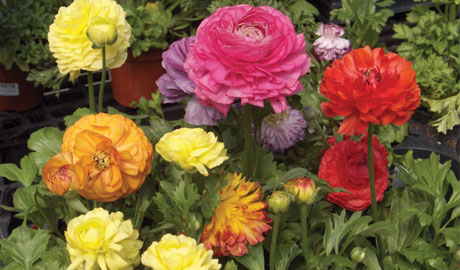Ranunculus

Ranunculus are better known to most people as Buttercups. The wild ones are European immigrants that have made themselves completely at home in the New World. Their beautiful double flowers look almost like miniature peonies, but their color range is much wider including red, white, yellow, pink, gold, and orange. The Persian reference in the common name is from the legend that a shy, handsome Persian prince died of longing because he was unable to declare his love for a nymph. After his death he was changed into the flower we know today. Persian buttercups become available as blooming pot plants in late winter and are a wonderful spirit-lifter until plants begin to bloom outside.
Tips for Growing Ranunculus Indoors
Indoors, ranunculus like it bright, but avoid the full hot sun since they also like it cool to prolong the life of the flowers. The cooler you can keep them, the better. A place near an east window would be ideal.
Ranunculus do not like to dry out. Keep them evenly moist but not soggy. If they are watered adequately, they do well with indoor humidity as long as they are not near a heat source or draft. Any good potting soil will do. They really aren’t fussy as long as it is well drained.
Feed them once a week as they are growing and blooming with a water-soluble fertilizer. Remove spent flowers as they fade.
Ranunculus naturally go dormant in summer. They are difficult to rebloom in a pot, but can be used outdoors the next season. Keep your plant well-fed until it goes dormant and then store it as recommended for garden-grown tubers (see growing ranunculus outdoors).
Tips for Growing Ranunculus Outdoors
Ranunculus may be planted outdoors two weeks before the last frost which is mid-May for our area. They prefer very good drainage, so growing them in raised beds or sandy soil is preferred. Ranunculus can be grown from seed but is much more commonly sold as a bulb called a claw. Soak the “claws” in water for an hour but no longer before planting. Plant them 2 to 3 inches deep and 4 to 5 inches apart. They grow well with partial to full sun.
Begin feeding them once a week when the bloom stalks appear. Stop when the leaves begin to yellow as they begin their dormancy.
As soon as the foliage has yellowed in summer, dig the tubers and store them in dry sand or peat moss in a frost free place until the next spring. This will simulate the dry summers they have in their native habitat.
